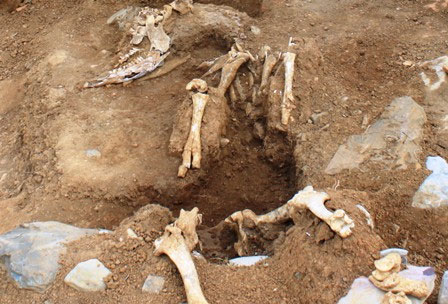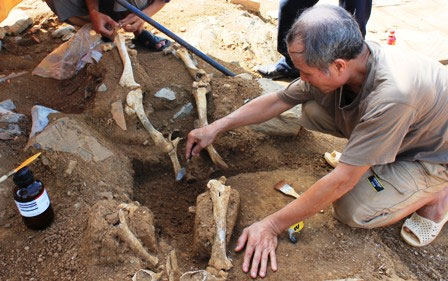Thanh Hoa: Detecting sacrifices in Dan Te Nam Giao
This is the first time archaeologists have discovered and excavated an animal bone sample of a sacrifice in Nam Giao esplanade of many feudal Vietnamese dynasties. According to historical records, when building the Nam Giao sacrifice, the kings often worshiped gods with buffaloes, cows, goats and pigs, and then buried carefully.

The buffalo skeleton is quite intact.
The buffalo skeleton was discovered during the process of restoring and restoring Nam Giao Esplanade of the World Cultural Heritage of Ho Dynasty (Vinh Loc District, Thanh Hoa).
The newly discovered buffalo skeleton is relatively intact, buried in the middle, beneath the third, outer, north and largest wall of the altar. Archaeologists are collecting samples of the above buffalo bone to study, then, can restore this skeleton to serve tourists visiting the Ho Dynasty's heritage.

Archaeologists are conducting a collection of bone samples at the detection site.
According to the archaeologists, of the Vietnam Institute of Archeology, it is possible that when building Nam Giao sacrifice in 1402, King Ho Quy Ly used buffaloes to worship gods, heaven and earth, then buried This buffalo falls on the wall of the altar. Currently, scientists are studying the above buffalo skeleton.
- 5 terrifying archaeological discoveries related to human sacrifices
- 7 very worldly ritual sacrifices of living people
- Many discoveries at the archaeological site of Con Moong cave
- South Korea discovered new evidence of human sacrifices
- Excavation of a series of killed children bones as sacrifices
- Detecting an ancient stone site built Ho's Citadel
- New discoveries on human sacrifice: Help strengthen power in a classifying society
- The truth about the Indian sacrifice of sacrifices
- Detecting the stalactite block 'unique' in Phong Nha cave
- How does the custom of killing the Aztec gods take place?
- Mexico found the body of the child who used the spirit in ancient Aztec temple
- Chinese diving ship caught the
 Discovered an ancient centipede fossil 99 million years old
Discovered an ancient centipede fossil 99 million years old Discovered bat-like dinosaurs in China
Discovered bat-like dinosaurs in China Discovered a 200-year-old bronze cannon of the coast
Discovered a 200-year-old bronze cannon of the coast Discover 305 million-year-old spider fossils
Discover 305 million-year-old spider fossils